The Big Read: Pedal into the world of Bromptons and Pinarellos, where cycling isn't just exercise but a lux lifestyle
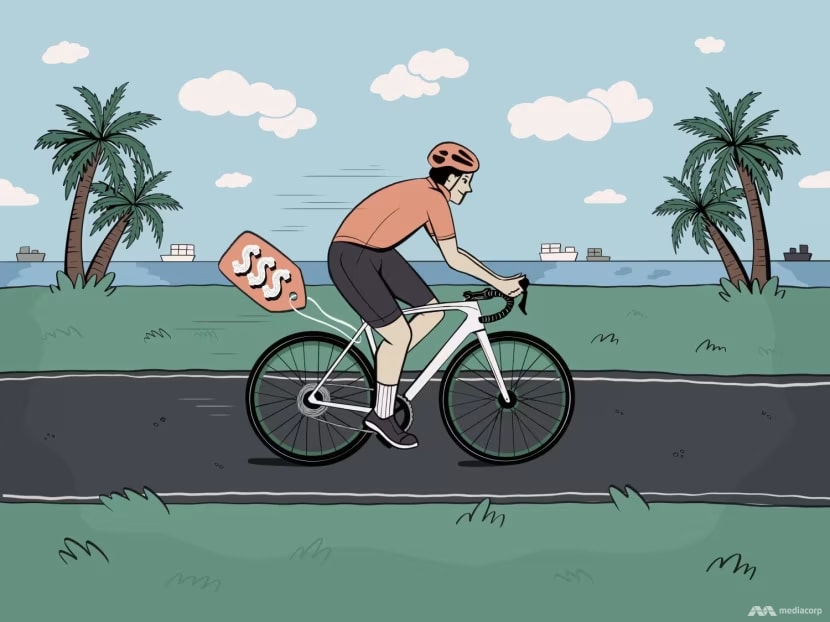
Although interest in cycling in general has abated since its peak during the COVID-19 pandemic, the subculture surrounding premium bicycles - which cost upwards of S$5,000 apiece - is still going strong, according to those in the fraternity. (Photo: TODAY/Nurjannah Suhaimi)

This audio is generated by an AI tool.
SINGAPORE: Although he began cycling using BMX bicycles in his teenage years, Mr Muzzamel Mazidee felt the urge to upgrade to a more expensive model only when he was in his mid-20s.
That lightbulb moment arrived in 2019 as he and his friends were cycling on the road, and he found himself unable to catch up with them. While he was riding a commuter bike, they were riding road bikes, which are generally lighter and speedier.
“The moment I could not catch up, I knew that apart from my fitness, I also was not on the right type of bike,” said the 31-year-old general manager of a tech start-up.
Mr Muzzamel decided to go for a S$3,000 (US$2,200) bicycle - a mid-range model of the American brand Specialized he had chosen - as he felt that he would have been tempted to spend more money to frequently upgrade the bike if he were to start with an entry-level range anyway.
Fast forward to May 2023, and he nonetheless upgraded to a bespoke bicycle from Australian brand Bastion.
With a name like Superleggera and using ultra-light carbon fibre material, the top-end model cost Mr Muzzamel about S$30,000 to put together.
While having a custom-made bicycle means it will be carefully put together taking into account one’s physical measurements to give as comfortable a riding experience as possible, Mr Muzzamel said there was more to the purchase as well.
“Having a bespoke bike is almost similar to having an art piece,” he said, comparing it to how other people may indulge in other forms of high-value items like watches or cars.

While his willingness to splurge on a two-wheel pedalling machine may raise some eyebrows, Mr Muzzamel is not alone; there are many others like him who burn rubber a few times each week on a tour de Singapore riding high-end bicycles in groups.
Although interest in cycling in general has abated since its peak during the COVID-19 pandemic, the subculture surrounding premium bicycles - which cost upwards of S$5,000 apiece - is still going strong, according to those in the fraternity.
Beyond going for rides in groups here or overseas, some of these avid cyclists spend significant amounts upgrading or modifying their gears, for various reasons such as better performance. Others also routinely post their adventures via dedicated social media accounts, which are also used by various cycling groups to organise rides and showcase their activities.
Premium bikes and their eye-watering price tags recently attracted public attention here again, albeit in a less positive light, after it was reported that a S$7,900 foldable Brompton bicycle was allegedly gifted to former Transport Minister S Iswaran who is currently facing corruption charges.
The same British brand of bikes had previously come under the spotlight when it emerged in 2012 that the National Parks Board had bought 26 of this brand of bicycles at S$2,200 each, leading the public to question whether the agency got value for its purchases.
This case also resulted in a former National Parks Board officer being charged and later fined S$5,000 for lying to auditors about his relationship with a bicycle firm director.
More recently, Brompton is also sponsoring for the first time a new race category in the upcoming OCBC Cycle event this year, dubbed the Foldie Ride.
To date, it is the only adult category race that has been fully subscribed.
What might be less known to those outside the cycling circle is that while S$7,900 or S$2,200 are not small sums, they represent just a fraction of how much some cycling enthusiasts are willing to spend on their hobby.
In fact, there are even bicycle wheelsets alone that come with five-figure price tags. Some high-end components such electronic groupsets can also cost over S$5,000.
The reasons for the willingness to pour big money into these bikes vary; from utilitarian ones such as better-build quality and resale value, to intangible ones such as peer influence and sheer passion, according to retailers and cyclists TODAY spoke to.
But who exactly are these diehards?
While many of them are mainly middle-aged male professionals with money to spare, over the years more women and younger riders have also entered the fold, said those in the fraternity.
Their motivation for spending time and money on this pastime goes beyond the health benefits that naturally come with the activity, cyclists told TODAY.
The activity also allows them to expand their social and professional networks, though the cyclists described this as more of an inadvertent benefit.
Still, they stressed that underneath the occasionally uniformed lycra and pricey equipment - which might look formidable to those outside their circle - they are a diverse and welcoming group.
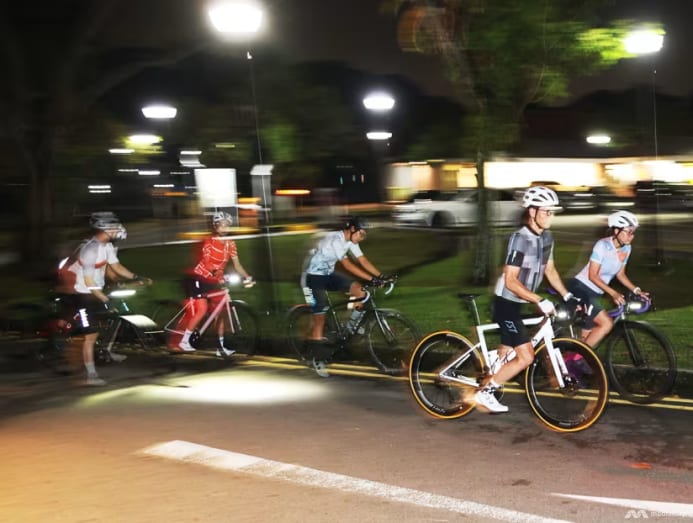
SOME TWO WHEELERS MORE FANCY THAN OTHERS
Bicycles mostly have just two wheels but the price disparity between different brands can be like night and day.
For example, premium folded bikes like Bromptons and Birdys carry a listed retail price of anywhere between S$2,000 and S$8,300, compared to the more mass-market variants that can cost as low as about S$300.
Similarly, road bikes of the more affordable variety can retail for about S$700 here.
At the other end of the price spectrum, a premium bicycle frame alone can cost more than S$10,000, excluding other components such as a groupset (cranks, brakes, derailleurs, gear shifters and so on), wheels, handlebars and saddles that cost in the hundreds or thousands of dollars per part.
For instance, a handlebar from Italian brand Pinarello retails for about S$1,500.
Costlier bicycles typically use higher-end components. Most are also made of carbon fibre - a strong, lightweight material - as opposed to aluminium for mass consumer bikes.
High-end bicycles can weigh as light as 6.5kg, less than half of mass market ones.
Naturally, those who are willing to fork out the moolah for such costly machines would typically also splurge on cycling apparel.
While a nondescript cycling jersey can cost under S$30, a branded top from the likes of Pas Normal Studios, Rapha or Maap can easily cost more than 10 times that.
Prices for helmets, bibs, sunglasses and shoes are no less steep, which means that one can easily spend over S$1,000 to be decked out in branded cycling apparel from head to toe.
As it turns out, cyclists and retailers alike said that there are tangible reasons to spend big bucks on their rides.
Mr Desmond Cheong, head of retail at Specialized, said: “If a bike has gone through more research and innovation, there's a performance benefit. And when there's a performance benefit, that’s what you pay for. So that's where the pricing varies.”
Specialized offers a broad range of two-wheelers with prices ranging from around S$2,000 for its entry-level offerings to S$20,000 for its highest-end S-Works range.
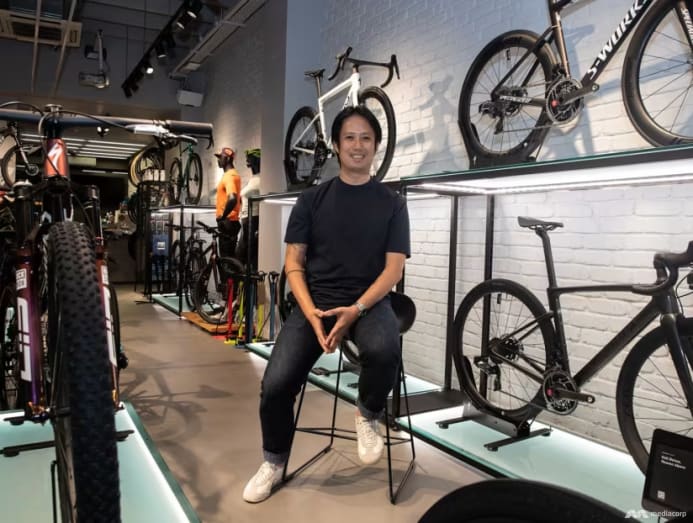
As for the popularity of Bromptons, its managing director for the Asia Pacific region Mark Smedley said that it has been driven by "a growing emphasis on sustainable and efficient urban transportation solutions".
"This uptrend reflects a shift towards compact and versatile options, aligning with Singapore's focus on eco-friendly mobility initiatives."
On why they appeal better to certain consumers over a more affordable folding bike, Mr Smedley said that while Brompton offers premium products, "it is everything around it that makes our brand special".
"As a B Corp we are really driven by our values, our commitment to our customers, our own people, our planet, and our partners to be a business for good," he said.
A B Corporation refers to a company that is certified and has voluntarily met the highest standards for social and environmental performance.
There are various cycling groups on social media set up by Brompton enthusiasts. These include Brompton_Riders@SG, a Facebook group which has about 15,000 members.
Mr Eugene Lim, an avid Brompton bicycle rider since 2010, said: "Value wise, as the bicycle is very well built and manufactured to last, amortising a good bike over 10 years offers more value than a S$500 bike which will not last more than three years."
Mr Lim is also a director at Camp High Achievers, a training consultancy firm which has sold Brompton bikes and offered related services such as guided tours since 2020.
Another pragmatic reason for buying more famous higher-end bicycles is that they tend to sell better in the resale market than their lesser-known counterparts.
OLC, a 31-year-old avid cyclist who runs a bicycle-focused YouTube channel under the moniker Oompa Loompa, sold his first bicycle and used the proceeds to fund a higher-priced bicycle.
In picking his second bicycle frame, brand reputation again played on his mind.
"I know that because of the brand name, people out there will still want to buy it (if I sell it later), as it is a reputable brand. Unlike buying an unknown frame, where the depreciation is much higher," said OLC, who declined to give his full name as being a mysterious, masked character is part of his YouTube persona.
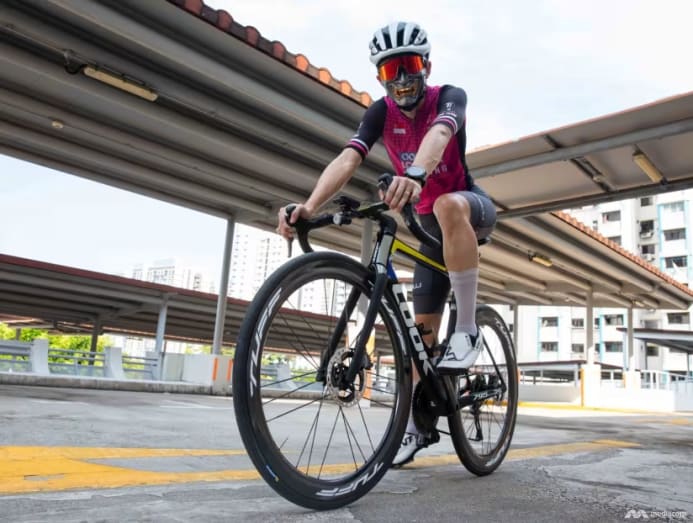
However, as with any product, there are aspirational aspects behind the decision to spend on big-ticket items as well.
Ms Lau, who works in the aviation industry, spent over S$3,000 on her Giant bicycle and related accessories when she started road cycling two-and-a-half years ago. A significant sum no doubt - but still modest compared to some others.
“I mean, I have friends who ride S$20,000 bicycles and whenever there’s a new (bicycle) jersey launch, they spend S$1,000 to S$2,000 on buying a new jersey,” she said.
This is akin to how other people might splurge on branded bags or watches because they like them, she added.

Other popular high-end brands here for road bikes include Trek, Specialized, Cervelo, Canyon, Bianchi, Factor and Pinarello, the Italian brand which is sometimes touted as the Ferrari of bicycles.
Despite paying a hefty price tag, some cyclists acknowledged that not everyone can feel or benefit from the improved performance that higher-end gear can offer, as it would depend on other fundamentals such as one’s physical stamina and cycling technique.
OLC, who regularly interviews cyclists for his YouTube channel, said he has come across a number who said that they buy certain bicycle brands as they would like to imitate their favourite athletes, or simply for the brand "prestige or heritage".
And as some put it, such expensive purchases are just a case of desire meeting spending power.
"As with any hobby, if one is passionate about it, you'll be willing to spend a significant amount of time and money on it," said Mr David Ho, coordinator of cycling group West Coast Riders, which welcomes cyclists of varying riding competencies.
"However, the amount one spends really depends on what you want to achieve out of it, and the affordability (to you)."
West Coast Riders has over 3,400 members on Facebook. Between 70 and 150 cyclists would take part in their rides, which happen three times a week.
In most cycling groups here such as West Coast Riders, each ride can stretch for anything from 40km to 80km, with cyclists grouped according to their rolling speeds, which can range from 20kmh to nearly 40kmh.
WHO BUYS THESE BIKES?
TODAY reported last year that cycling activities and bicycle sales in general have declined from their COVID-19 peak.
Mr Eric Ng, a professional airbrush artist of 18 years whose shop Paint Extreme does mainly custom artwork for premium bikes, said that the decline is due to “impulsive buyers” leaving the market as other leisure activities opened up after the pandemic.
Mr Azhar Abdullah, Treknology3’s retail, marketing and distribution manager said that the “entry to mid-segment” bikes were the ones that saw the most fluctuation, as these were the bicycles that casual cyclists back then went for.
Treknology3 is the authorised distributor of bicycles from popular American brand Trek, which produces mass consumer models as well as high-end ones used by professional race cyclists.
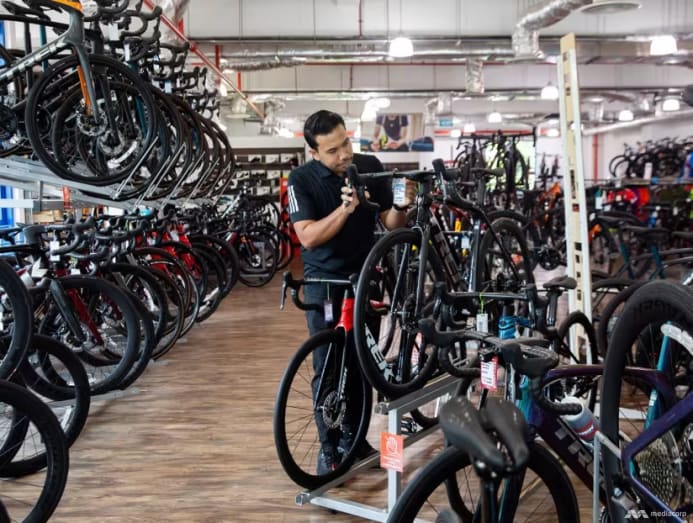
Mr Kenneth Tan, co-owner of high-end bike dealer Cycleworx, said that the drop has been so drastic that some shops are selling their stocks at a loss, or closing down entirely.
In the past year, cycling as a sport has seen a "market correction" back to pre-pandemic levels, with some signs of gradual growth, retailers told TODAY recently.Meanwhile, demand from the more "serious" cyclists who have been investing in gear, has remained largely steady through the years, the retailers said.
So, who are these loyal consumers of high-end gear, attire and even bike customisation services?
One term popularised since around the 2010s to describe such cyclists is Mamil - middle-aged men in Lycras. According to most cyclists and retailers, this group still make up a significant number of their consumers.
Mr Tan of Cycleworx, a dealer for Pinarellos that typically retail for five-figure sums, said the bulk of his customers are still male professionals, usually in their late 30s and above.
But female riders, and younger riders across genders, are also a growing demographic among avid cyclists over the years.
Music educator and avid cyclist Melodie Ng said: "I would see three guys to every one lady (per group). I think previously this would have been much less."
Co-founder of Cycle Project Store, Sherwin Ng, also noted a "refreshing" increase in female riders in the otherwise male-dominated scene since the COVID-19 pandemic.
"The increase could also be due to social media, better gear designed for women such as apparel, equipment and so on," said Mr Ng.
Mr Gino Abano, managing director for Specialized Asiahub, cautioned against presuming a link between having financial means and a willingness to spend.
"I can think of a number of people, who are not exactly big executives, owning the most expensive bikes. And it’s also true the other way around," he said.
"I think it’s less to do with income or profile, and more to do with how interested they are in riding the bike and what they want out of it."
Mr Azhar of Treknology3 added that the barrier to buying pricier bicycles nowadays is also lower with the availability of easier payment options.
"We see more people using the instalment option as well. But I will say for us as a business we don't really see a big jump," he said.
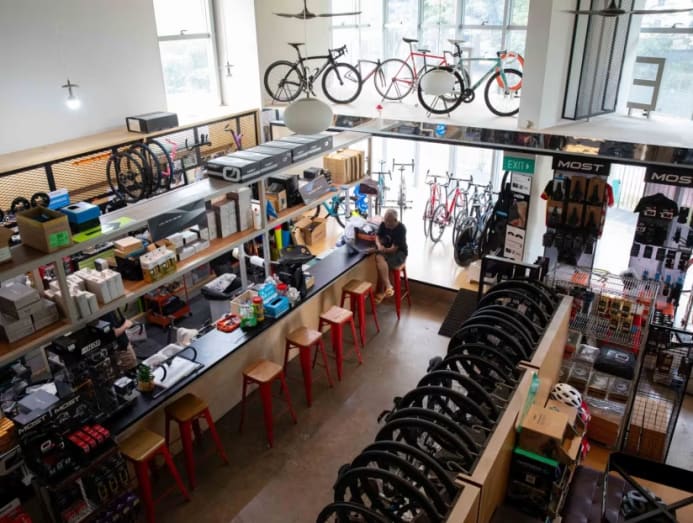
A "SECOND GOLF" OR JUST A CHILLOUT SESSION?
As premium bike groups in Singapore attract more followers, is high-end cycling becoming the "new golf" here?
The concept of networking on wheels - bandied around since at least the 2010s - refers to individuals using cycling as a means to extend their professional networks, given that people who can afford to splurge on leisurely activities are likely to be well-heeled or established in their careers.
While cyclists and retailers here agreed that people may cycle to connect for professional reasons, they differed on the extent of such a practice, and whether the networking that developed is by design or accident.
Mr Ng of Paint Extreme described high-end bike cycling as a "second golf", as it offers potential opportunities to mingle with high-profile professionals or business leaders.
Compared to signing up for a country club membership, or partaking in other activities that the rich may indulge in like driving luxury cars, buying a performance bike is something more accessible to even "those with just above average income", he added.
Still, others said that the majority who commit to cycling do it for the company and the joy of the activity. Networking, if it does happen, occurs inadvertently, they added.
Mr Tan of Cycleworx said those who deliberately join cycling groups for the sake of networking tend to stand out from cyclists who are actually passionate about the sport, and tend to number "just one or two" in a group.
"They also usually don't last long," added Mr Tan, a former SEA Games medallist in the late 1980s to mid-1990s.
Mr Muzzamel said that even though he sees high net-worth individuals in his group, he cycles first and foremost "to get away from work".
As he expects that other professionals also feel the same about cycling, he refrains from talking shop with them.
However, he also acknowledged that if one were to mix among the right group of people, you are “bound to” meet with certain people that they can potentially find certain business dealings with. This applies to cycling or any social group.
Riders said that going cycling is no different from other forms of hanging out with friends - except that this particular group of people share a common interest in bicycles.
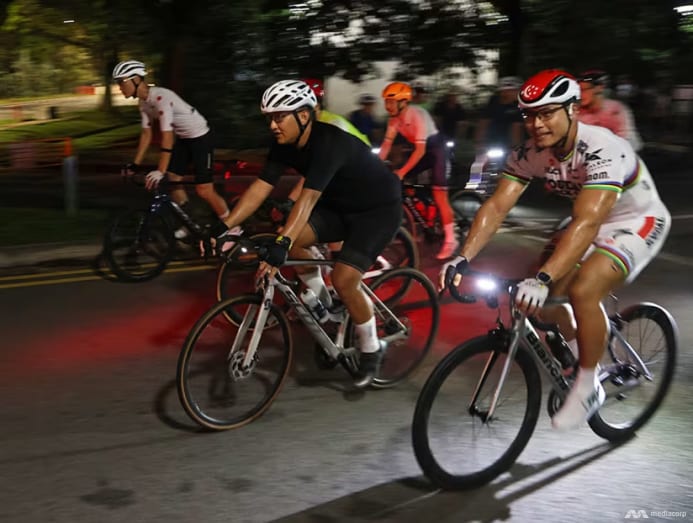
On top of riding, chilling, chatting and swooning over the newest and shiniest gear together, a growing number of riders are also manifesting their passion for their two-wheelers through content creation.
OLC, Ms Lau and Ms Ng have all been uploading cycling-related content on their various social media platforms.
OLC’s Oompa Loompa YouTube channel which features interviews with other bikers and gear reviews, has gathered almost 19,000 subscribers, a “sizeable number” but not enough to “replace a day job”, he said.
For Ms Ng, while she started road cycling a few years ago upon the recommendation of an ex-colleague to try the sport, she has “become like a (content) creator of sorts”.
“Not everyone obviously does it that way. It just happens to be what I'm interested in, I love making videos,” said Ms Ng, who has 4,700 followers on Instagram.
Ms Lau has about 9,000 followers on her tiffylauonwheels Instagram account.
Mr Dean Koh, vice-president for media and publicity at the Singapore Cycling Federation said that “the rise of cycling influencers” is one of two factors that has contributed to the high-end bicycle subculture here.
The other factor, he said, is the proliferation of local cycling clubs that keep cyclists “active in their passion” by organising regular group rides.
IS LUXURY BIKE CULTURE THE WAY FORWARD?
Retailers here noted that some of the local cyclists' preference towards more premium rides is not too dissimilar from that of other markets.
Mr Cheong of Specialized said that comparing Singapore with other markets, there is no drastic difference in demand for their various tiers of bicycles.
However, anecdotal evidence points to cyclists here having a more upmarket taste in bikes than those in neighbouring countries.
Ms Lau, for example, said that when she goes cycling in Bangkok and meets avid cyclists there, she notices that Singaporean riders tend to have more expensive bikes than their Thai counterparts.
Mr Gary Gleason, vice-president of sales at American mountain bicycle brand Wilderness Trail Bikes, noted that his company serves high-end riders who use upscale accessories in Singapore.
"It seems that the market is really kind of catered towards a more premium product," he was reported as saying at the recent Taipei Cycle 2024, Asia’s biggest bicycle trade show.
Mr Ng of Cycle Project Store added: "The cycling community here in the Southeast Asian region are fast paced with their consumption of products and generally after the newest or latest release as compared to certain parts of the world."
While those in the fraternity believe that the subculture surrounding premium bikes in Singapore is here to stay - given its resilience throughout the pandemic - some reiterated the importance of not losing sight of the wider cycling populace here, too.
Active mobility expert Tham Chen Munn, a former vice-president for recreation at the Singapore Cycling Federation, said that while the Lycra-clad road riders with their expensive bicycles may be more prominent, there is also the "unsung, unseen" group of bike users who ride around the neighbourhoods on shared paths.
"And when the Park Connector Network continues to expand, who does this benefit? It’s the uncles and aunties and families who use these paths, not the road cyclists," he said.
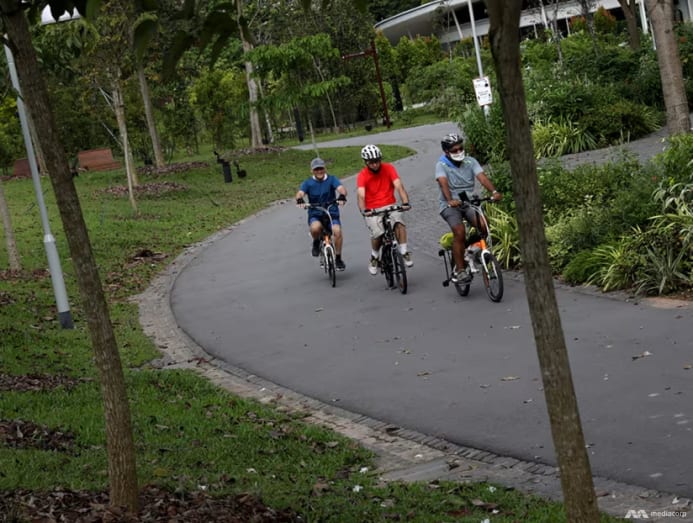
Mr Koh of SCF added that those who are bitten by the cycling bug but are more budget-conscious can always turn to the resale market for good deals or big retailers that offer more affordably priced equipment to get started on the hobby.
At the end of the day, Mr Tham reiterated that cycling is still an activity for all and not something reserved for the more affluent.
Agreeing, Mr Ho of West Coast Riders said: "You can still cycle with a low-cost bike, accessories and kits. However, if you want to follow trends, or keep up with the Joneses, then the sky's the limit.
"The main reasons (for cycling) will still be the same: Fitness, social bonding and adventure."
This article was originally published in TODAY.






.JPG?itok=0sAtRO8R)





